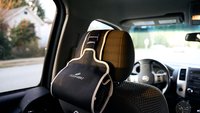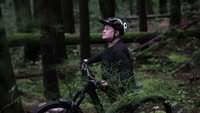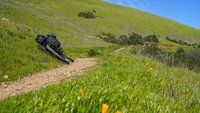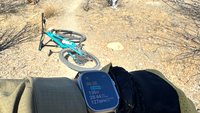I've been watching the xc showdown on pinkbike. All the bikes have a 74 deg STA and 69 degrees hta. As a roadie (also) and old guy I don't mind my bikes having slack sta's. I feel like you get better power back there. Also, I guess there is an advantage of having more room when not using a dropper. I don't keep up with xc tech but I am curious what the main reason is for keeping such traditional geo. The xc courses are certainly not all that tight or technical to require a short wheelbase. I've also never had issue with the slacker hta when going uphill or on fast pedally sections. If anything, I generally prefer it. In the trail and Enduro world there has been very little hesitation to adopt aggressive changes in angles, in blown away by xc's ability to hold the course
interesting how slow xc is to adopt modern geo
Could the slack seat angle be for wattage? Not sure if you've ever had a pro roadie fitting or it's just a gut feeling, but the further your saddle goes back the higher the measured wattage output is. Also the less comfortable it gets, but not sure if that's even a factor for the pros.
Steep head angles maybe just to keep the front end sharp on the climbs? Descent is just a place to catch your breath before the next uphill effort anyhow right?
Then again maybe it's tradition keeping things conservative. Look at all the outdated crap roadies kept running long after it made any sense.
Last edited by: Hepcat on July 29, 2020, 7:24 p.m., edited 1 time in total.
Nico and Katy had pretty interesting bike setups a few weeks ago. With XC you’ll win or lose more races on the climbs than on the descents.
Long front centre and slack HTA is not as good for flat corners where you need to extra weight the front wheel.
XC riders corner while seated more too.
For the pinkbike showdown you refer to, only ~2 bikes have 69 degrees or steeper.
I have been experimenting with a Works angle adjust headset on an Element, going from 69 degrees to 67.5. It wasn't as night and day as I expected, and since the bearings began to make lots of cracking noise I went back to the original headset and didn't die going over the bars.
I think to make long and slack work, you also need a much grippier front tire, which usually means more rolling resistance (and slower overall)
The less rear travel you have, the less steep your static (unsagged) seat angle needs to be. As rear suspension sags and bobs under pedalling, the seat angle becomes slacker.
My Chromag Rootdown has a 76 degree seat angle and I actually find the need to slide the seat back on its rails to not feel uncomfortably perched forward on all but the steepest climbs. In contrast, a 76+ degree seat angle on an enduro bike feels pretty normal since it might sag to something like 73 degrees under weight and pedalling.
Posted by: D_C_
The less rear travel you have, the less steep your static (unsagged) seat angle needs to be. As rear suspension sags and bobs under pedalling, the seat angle becomes slacker.
My Chromag Rootdown has a 76 degree seat angle and I actually find the need to slide the seat back on its rails to not feel uncomfortably perched forward on all but the steepest climbs. In contrast, a 76+ degree seat angle on an enduro bike feels pretty normal since it might sag to something like 73 degrees under weight and pedalling.
This. Dynamic geo makes more of a difference than just looking at static geo numbers.
There was a comment on one of the reviews (Scalpel?) about it's bb height being higher than the Supercaliber by 11mm, so it felt 'less planted when cornering' or something. The Scalpel has 100mm of travel, and the Supercal has 60mm. So where is the BB on the Scalpel when you sit on it compared to the Supercal? And then where is it as soon as you start using travel? And then where does it end up when you're at 80% of travel Vs 80% of travel on the Supercal?
Do the math and you see that static geo comparisons can be completely meaningless. Especially from Pinkbike.
XC bikes are designed to be raced/ridden from the saddle, Vs Enduro bikes which are designed to be raced/ridden from a standing position. The weighting of the bike is completely different in those two different use/design cases. Until there's a round of the XCWC where you can make up 2 minutes a lap (over a top ten rider) on the descent, that's how XC bikes will stay.
Now DC/BCXC/marathon bikes might get more interesting - those are bikes/races that CAN make a 2 minute gap on a descent. I imagine at the end of a long day in the Cape Epic for example.
XC mtbs don't really seem to exist in this part of the world due to terrain. I don't have any friends who have one. Many have boutique Cromag style slack hardtails, beefed up for the riding here. In my circle those who wanna ride xc race style of riding have gravel bikes. The trek caliber top build looks like a super sick bike...would love to try one out, but have never seen anyone riding one. Do the local shops even sell xc race bikes?
What about rear-wheel-traction? Not being as far forward on the bike might be beneficial for that purpose. Considering the kind of power pro-racers can put down, keeping the rear wheel from spinning is probably important.
Agreed that static angles are almost meaningless. The problem with a steep seat tube angle is that it can change your seated balance. As your feet move under your butt by either the seat being moved forward or the bb moving backwards, you may end up leaning on the bars more. To fix that you need to either raise the bar, which makes pedalling less efficient, or move the seat back and/or feet forward. To a certain extent the steep seat tube angle thing is a fad and marketing thing to try and sell new bikes. In XC racing the riders already have a more leaned over aggressive position and they don’t really set the bike up for comfort. Emily Batty seems to be an outlier in her set up. For us punters who ride longer travel bikes for the downs, we can get away with a less efficient platform for climbing and go more for comfort. The steep seat tube angle is more efficient in terms of maintaining traction on a climb but less efficient in terms of a pedalling platform.
Could it be as simple as wanting their XC seat angle to match their road bike seat angle?
Elites that I've known anyway have done almost all of their training mileage on the road bike.
XC race bikes really are off on their own distinct evolutionary branch of MTB aren't they.
Posted by: Hepcat
Could it be as simple as wanting their XC seat angle to match their road bike seat angle?
Elites that I've known anyway have done almost all of their training mileage on the road bike.
XC race bikes really are off on their own distinct evolutionary branch of MTB aren't they.
Could be.
After reading the replies, a few thoughts have come to mind.
I think most Enduro bikes are designed for a person of moderate fitness and flexibility. I suspect many riders don't have the hip and back flexibility to reach a low bar to get your weight over the front on climbs so the geo just move the seat forwards.
XC bikes are designed for a fitter more flexible crowd so they achieve the front wheel tracking on climbs with core strength and a low stack.
I also didn't really consider the seated cornering being a significant component of the geo but that makes sense.
Do you think the longer reach is that much better for descending or is it just better for those with less hip/back flexibility?
I always suspected that a slacker STA was a better position for power but didn't know it was a proven theory.
Posted by: Timer
What about rear-wheel-traction? Not being as far forward on the bike might be beneficial for that purpose. Considering the kind of power pro-racers can put down, keeping the rear wheel from spinning is probably important.
You’re underestimating how great the effect chainstay length has on climbing traction.
YouTube Hill Climbing Dirt Bikes and look at how long the swingarms on those bikes are.
Posted by: Endur-Bro
Posted by: Timer
What about rear-wheel-traction? Not being as far forward on the bike might be beneficial for that purpose. Considering the kind of power pro-racers can put down, keeping the rear wheel from spinning is probably important.
You’re underestimating how great the effect chainstay length has on climbing traction.
YouTube Hill Climbing Dirt Bikes and look at how long the swingarms on those bikes are.
Yes. When 29ers first came out it was common that people noticed better climbing. I think the the primary reason for that was the longer chainstays required by the bigger wheel.
Posted by: Endur-Bro
Posted by: Timer
What about rear-wheel-traction? Not being as far forward on the bike might be beneficial for that purpose. Considering the kind of power pro-racers can put down, keeping the rear wheel from spinning is probably important.
You’re underestimating how great the effect chainstay length has on climbing traction.
YouTube Hill Climbing Dirt Bikes and look at how long the swingarms on those bikes are.
those hill climbers have far more power and torque than any cyclist, and are in near wheelie balance their whole run
the longer chainstay makes it easier to stay at the balance point, such as its easier to balance a baseball bat on your forehead than a pen, it damps/slows movements away from the balance point
I bet tall xc racers could benefit from longer chainstays too, because easier to modulate
Last edited by: taprider on Aug. 2, 2020, 4:24 p.m., edited 2 times in total.
Forum jump:







